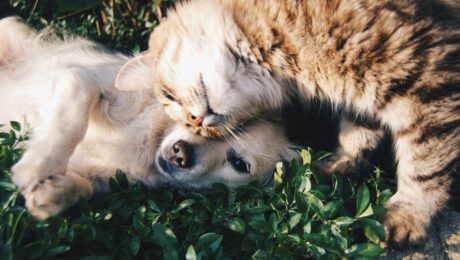DIY Pet Toys: Fun and Easy Projects for Your Furry Friends
As pet owners, we all want to provide our furry friends with the best toys to keep them entertained and engaged. However, store-bought pet toys can be expensive and sometimes not as durable as we would like. That’s where DIY pet toys come in! Not only are they a fun project to do with your pet, but they are also cost-effective and can be customized to suit your pet’s preferences. In this blog post, we will explore some fun and easy DIY pet toy projects that you can make for your beloved pets.
One of the simplest DIY pet toys you can make is a sock toy. All you need is an old sock, some stuffing (which can be cotton balls or even old fabric scraps), and a few treats or catnip to entice your furry friend. Simply stuff the sock with the filling, add the treats or catnip, and tie a knot at the top. Your pet will have hours of fun trying to get the treats out of the sock!
Another great DIY pet toy idea is a cardboard box maze for cats. Cats love exploring small spaces and hunting for hidden treasures, so creating a maze out of cardboard boxes can provide endless entertainment for your feline friend. Cut holes in the boxes for entryways and exits, add some crumpled paper balls or toys inside for them to discover, and watch as your cat has a blast navigating through their very own maze.
For dogs who love to play fetch, a homemade rope toy is a perfect option. All you need is some old T-shirts or towels that you no longer use. Cut them into strips, braid them together, and tie knots at each end. Not only does this toy provide hours of entertainment for your pup, but it also helps with their dental health by cleaning their teeth as they chew on the rope.
If you have rabbits or guinea pigs as pets, a DIY tunnel made from PVC pipes is an excellent choice. Simply connect several PVC pipes together to create a tunnel structure that your small pets can run through and explore. You can even add additional elements like hanging toys or treats inside the tunnel to keep them engaged and active.
DIY pet toys are not only fun to make but also provide endless entertainment for your furry friends without breaking the bank. By using simple materials that you already have at home, you can create custom toys that cater to your pet’s specific interests and needs. So why not get creative and start making some DIY pet toys today? Your pets will thank you for it!
- Published in Pet Essentials
Decoding Your Cat: Understanding Their Behavior
Cats are mysterious creatures that have captured the hearts of millions around the world. From their purring to their playful antics, every move they make seems to hold a deeper meaning. As cat owners, it’s important for us to understand our feline friends better in order to provide them with the love and care they deserve. In this blog post, we will delve into the fascinating world of cat behavior and decode what your cat’s actions really mean.
One common behavior among cats is kneading, where they push their paws in and out against a soft surface like your lap or a blanket. This behavior stems from kittenhood when they would knead their mother’s belly to stimulate milk flow. So, if your cat is kneading you, it means they are feeling content and comfortable in your presence. It’s a sign of affection and trust.
Another interesting behavior exhibited by cats is grooming themselves excessively. While cats are known for being clean animals, excessive grooming could be a sign of stress or anxiety. If you notice your cats grooming themselves more than usual, try to create a calm environment for them and provide them with extra attention and comfort.
Cats are also known for their love of high places. They enjoy climbing trees, perching on shelves, or sitting on top of the refrigerator. This behavior stems from their natural instinct as predators who seek out vantage points to survey their surroundings for potential prey or threats. Providing your cat with tall scratching posts or cat trees can satisfy this need while keeping them entertained and engaged.
One common misconception about cats is that they are aloof and independent creatures who don’t crave human companionship. However, cats form strong bonds with their human caregivers and rely on them for social interaction and emotional support. If your cat follows you around the house, sits on your lap, or sleeps next to you at night, it’s a clear sign that they see you as an important part of their life.
Understanding your cat’s behavior is key to building a strong bond with them and ensuring their overall well-being. By paying attention to their actions and body language, you can decipher what they’re trying to communicate with you. Remember that each cat is unique and may exhibit different behaviors based on their personality and past experiences. So take the time to observe and learn about your feline friend so that you can provide them with the love, care, and understanding they deserve.
- Published in Pet Essentials
Wholesome Homemade Treats for Your Furry Friends
As pet owners, we always want to provide the best care for our beloved dogs and cats. One way to show them love and keep them healthy is by making homemade treats for them. Not only are homemade treats a great way to bond with your pets, but they also ensure that your furry friends are consuming nutritious ingredients. In this blog post, we will explore some easy and delicious recipes for healthy homemade treats for dogs and cats.
When it comes to making homemade treats for your pets, it’s important to use ingredients that are safe and beneficial for their health. For dogs, you can try making peanut butter and banana frozen treats. Simply blend together ripe bananas, unsalted peanut butter, and a splash of water before pouring the mixture into ice cube trays and freezing until solid. These frozen treats are not only refreshing but also packed with potassium and protein.
For cats, consider making tuna catnip treats. Mix canned tuna with a small amount of catnip before forming small balls or shapes. Refrigerate the treats until firm before serving them to your feline friend. Tuna is rich in omega-3 fatty acids, which are essential for maintaining healthy skin and coat in cats. Catnip is also known to have calming effects on cats.
Another great option for dog treats is pumpkin peanut butter biscuits. Combine pureed pumpkin, unsweetened applesauce, peanut butter, whole wheat flour, and cinnamon in a bowl before rolling out the dough and cutting it into shapes using cookie cutters. Bake the biscuits until golden brown and let them cool before giving them to your pup. Pumpkin is high in fiber and vitamins A and C, while peanut butter provides protein.
For a simple yet tasty treat for cats, try making salmon crunchies. Mix canned salmon with oat flour or wheat germ until you achieve a dough-like consistency. Roll out the dough and cut it into small pieces before baking until crispy. Salmon is an excellent source of omega-3 fatty acids that support heart health in cats.
Making homemade treats for your dogs and cats is a rewarding experience that allows you to control what goes into their diet while showing them love through delicious snacks. By incorporating nutritious ingredients like fruits, vegetables, lean proteins, and whole grains into your pet’s treats, you can ensure that they stay happy and healthy. So why not give these wholesome homemade treat recipes a try? Your furry friends will thank you with wagging tails and purrs of delight!
- Published in Pet Essentials
The Importance of Regular Veterinary Checkups for Your Pet
As pet owners, we all want to ensure the health and well-being of our furry friends. One of the best ways to do this is by scheduling regular veterinary checkups for your pet. Just like humans need regular checkups with their doctors, pets also benefit from routine visits to the veterinarian. In this blog post, we will discuss the importance of regular veterinary checkups for your pet and why they are essential for maintaining their health.
Regular veterinary checkups are crucial for monitoring your pet’s overall health and detecting any potential issues early on. During these checkups, veterinarians can perform a thorough physical examination of your pet to check for any signs of illness or disease. They can also provide preventive care such as vaccinations, parasite control, and dental cleanings. By catching any health problems early, you can prevent them from escalating into more serious issues that may require costly treatments.
In addition to physical exams and preventive care, regular veterinary checkups also allow veterinarians to update your pet’s medical records and keep track of their growth and development over time. This information is essential for creating personalized care plans for your pet and ensuring they receive the appropriate treatments based on their age, breed, and lifestyle. Veterinarians can also offer valuable advice on nutrition, exercise, behavior training, and other aspects of pet care during these visits.
Another benefit of regular veterinary checkups is the opportunity to address any concerns or questions you may have about your pet’s health or behavior. Whether you notice changes in your appetite, energy levels, or bathroom habits, veterinarians can help diagnose the underlying cause and recommend appropriate treatment options. They can also provide guidance on how to manage chronic conditions such as arthritis or diabetes to improve your pet’s quality of life.
Regular veterinary checkups are not only beneficial for your pet’s physical health but also for their emotional well-being. Pets may experience anxiety or stress during certain situations such as visits to the veterinarian’s office. By making these visits a regular part of their routine, you can help reduce their fear and discomfort over time. Building a positive relationship with your veterinarian can also strengthen the bond between you and your pet and create a supportive environment for addressing any health concerns.
Regular veterinary checkups are essential for maintaining the health and happiness of your beloved pet. By scheduling routine visits with your veterinarian, you can ensure that your pet receives the necessary care they need to thrive throughout their life. Remember that prevention is key when it comes to keeping your furry friend healthy, so don’t wait until they are sick to schedule a checkup. Take proactive steps towards providing optimal care for your pet by prioritizing their regular veterinary appointments. Your furry friend will thank you for it!
- Published in Pet Essentials
Helping Your Furry Friend Adjust to a New Home
Bringing a new pet into your home is an exciting and rewarding experience. However, it can also be a stressful time for your furry friend as they adjust to their new environment. It’s important to take the time to help them feel comfortable and secure in their new surroundings. In this blog post, we’ll discuss some tips and tricks for helping your pet adjust to their new home.
Create a Safe Space: When you first bring your pet home, it’s essential to create a safe space where they can retreat and feel secure. This could be a cozy corner with their bed, toys, and water bowl. Make sure this area is away from loud noises or high-traffic areas so that they can relax and decompress.
Stick to a Routine: Pets thrive on routine, so try to establish a consistent schedule for feeding, walks, playtime, and bedtime. This will help your pet feel more secure and settled in their new environment. Consistency is key when it comes to helping your furry friend adjust.
Introduce Them Slowly: If you have other pets in the household, it’s crucial to introduce them slowly and carefully. Allow them to sniff each other through a closed door before gradually allowing supervised interactions. This will help prevent any potential conflicts and allow your pets to get used to each other at their own pace.
Provide Comforting Items: Familiar scents can provide comfort for your pet during the transition period. Consider giving them blankets or toys that smell like their previous home or littermates. This will help ease their anxiety and make them feel more at ease in their new surroundings.
Be Patient and Understanding: Remember that adjusting to a new home can be overwhelming for pets, so it’s essential to be patient and understanding during this time. Give them plenty of love and attention while also allowing them space when they need it. With time and patience, your furry friend will settle into their new home comfortably.
Helping your pet adjust to a new home requires time, patience, and understanding on your part as a pet owner. By creating a safe space, sticking to a routine, introducing them slowly to other pets, providing comforting items, and being patient with them during this transition period, you can ensure that your furry friend feels comfortable and secure in their new environment. Remember that every pet adjusts at their own pace, so give them the time they need to settle in fully.
With these tips in mind, you can make the transition smoother for both you and your beloved companion.
- Published in Pet Essentials
Exercise and Playtime: Keeping Your Pet Active and Healthy
As pet owners, we all want our furry friends to live long, healthy lives. One of the best ways to ensure this is by keeping them active through exercise and playtime. Just like humans, pets need regular physical activity to maintain a healthy weight, reduce stress, and prevent behavioral issues. In this blog post, we will explore the importance of exercise for pets and provide some fun ideas on how to keep your pet active and healthy.
Regular exercise is essential for pets of all ages and breeds. Not only does it help them stay fit and maintain a healthy weight, but it also promotes mental stimulation and reduces the risk of chronic diseases such as diabetes and heart disease. Dogs, in particular, require daily exercise to release pent-up energy and prevent boredom. This can be achieved through activities such as walking, running, playing fetch, or agility training. Cats also benefit from regular playtime to keep them mentally sharp and prevent obesity.
Interactive toys are a great way to keep your pet entertained while getting some exercise at the same time. Puzzle toys that dispense treats as they are played with can provide mental stimulation for dogs and cats alike. Laser pointers are another popular toy for cats that can get them moving around while trying to catch the elusive red dot. For dogs, interactive toys such as Kong toys filled with treats or tug-of-war ropes can keep them engaged both mentally and physically.
In addition to traditional forms of exercise like walking or playing fetch, consider incorporating other activities into your pet’s routine to keep things interesting. Swimming is an excellent low-impact workout for dogs that is easy on their joints while providing a full-body workout. For cats, consider setting up a DIY obstacle course using everyday household items like cardboard boxes or tunnels for them to climb through or hide in.
Another important aspect of keeping your pet active is socialization with other animals. Dog parks are a great place for your furry friend to run around off-leash and interact with other dogs in a safe environment. This not only provides physical exercise but also helps improve their social skills and behavior around other animals.
Regular exercise and playtime are essential for keeping your pet happy, healthy, and well-balanced. By incorporating various forms of physical activity into their daily routine, you can help prevent obesity, reduce stress levels, improve behavior, and strengthen the bond between you and your furry companion. So next time you’re looking for ways to keep your pet active, try some of the ideas mentioned in this blog post and watch as they thrive both physically and mentally!
- Published in Pet Essentials







